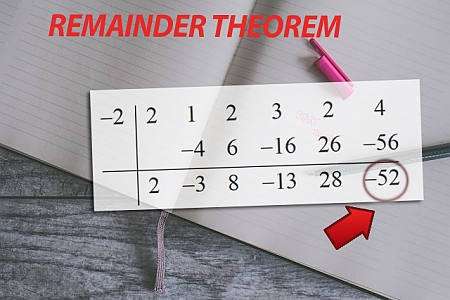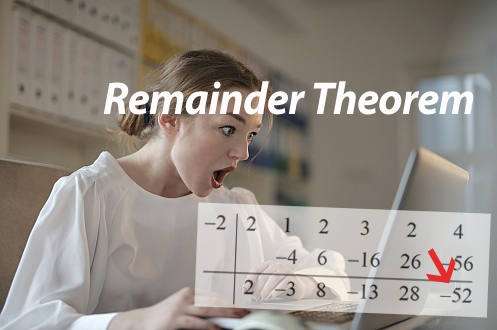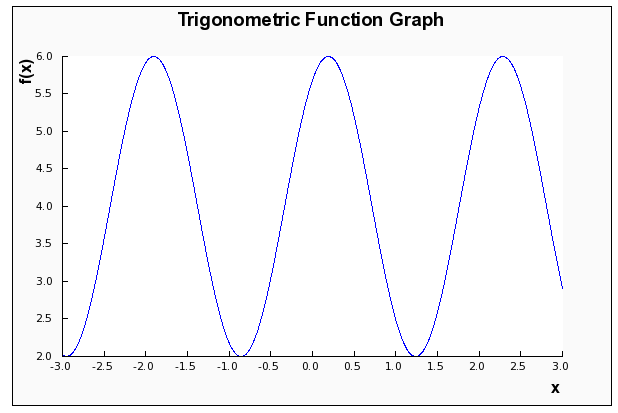Remainder Theorem
Instructions: Use this Remainder Theorem calculator to find the find the value of a polynomial p(x) at a certain value x = a, using the remainder of a division , showing all the steps. Please type in the polynomial you need to use and the value you want to evaluate at in the form box below.
Remainder Theorem Calculator
This calculator can help you efficiently and easily used the Remainder Theorem. In order to use it, you need to provide a valid polynomial (for example, something like 3x^4 - 3x^2 + 6) and a valid numeric expression (such as 2, or 3/4) where you want to evaluate the polynomial at.
The polynomial provided can have any degree you wish, as long as it is a valid polynomial. It can have integer or fraction coefficients, or ultimately any valid numeric expression can be a coefficient (like sqrt(2)). The polyonomial you provide can come simplified or not, it does not matter, as the calculator will simplify the polynomial first, if needed.
Once a valid polynomial is provided, with a valid numeric expression to evaluate it at, you need to push the "Calculate" button, and all the steps of the process will be provided to you.
The Remainder Theorem is of the upmost importance in Algebra, so you will that it will come in handy to have this calculator, to make the process a lot easier.

What is the Remainder Theorem
The Remainder Theorem is one important theorem that stated simply says that when you divide two polynomials, you will find a quotient and a remainder, both of them polynomials.
This brings memories of the division of numbers: when dividing two numbers, you find a quotient and a remainder, with the fantastic property that the remainder is less than the divisor. Exactly the same happens with polynomials, only that in that case, the degree of the remainder is lower then the degree of the divisor.
We have to put it mathematically: Assume that you have a polynomial \(p(x)\) and you want to divide it by \(s(x)\). The Remainder Theorem states that there exist a quotient \(q(x)\) and a remainder \(r(x\) with property that
\[\displaystyle \frac{p(x)}{s(x)} = q(x) + \frac{r(x)}{s(x)} \]where the degree of the remainder \(r(x)\) is less than the degree of the divisor \(s(x)\). These quotient and remainder can be found with the aid of the long division of polynomials.
The other angle of the Remainder Theorem is that the above expression can be rewritten as
\[\displaystyle p(x) = q(x)s(x) + r(x)\]Now, if the divisor has order 1, say \(s(x) = x-a\), the remainder theorem becomes
\[\displaystyle p(x) = q(x)(x-a) + r\]Now, \(r(x)\) becomes a constant \(r(x) = r\), because the divisor has degree 1, and then the remainder must have degree zero, which means the remainder is constant.
So then, plugging x = a in the above formula leads to
\[\displaystyle p(a) = q(a)(a-a) + r = q(a)\cdot 0 + r = r\]The conclusion, and bottomline of the Remainder Theorem is that p(a) is the remainder of dividing p(x) by (x-a), which can be done using synthetic division. This process of indirectly evaluating the polynomial at a value is called synthetic substitution.
Steps for using the Remainder Theorem
- Step 1: Identify the polynomial p(x) and the divisor s(x)
- Step 2: If you want to find the quotient and remainder, in general you can use the long division method
- Step 3: If you want to evaluate p(x) at a point x = a, simply divide p(x) by x-a using the synthetic division method
As you can see, the remainder theorem, division of polynomials, synthetic division and long division are tightly related to each other, and are different sides of the same object.
How do you benefit using the Remainder Theorem?
The remainder theorem is used in many capacities. Most typically, it is used to evaluate a polynomial at a given value x = a, and specifically, determine whether or not it is a root of the polynomial (if p(a) = 0).
Overall, the Remainder theorem gives you the flexibility of detecting roots, which is a crucial ability at the time of factoring polynomials.
Tips for success
Typically, when working with polynomials, it is more convenient to use synthetic substitution than direct evaluation, especially when you are doing work by hand.
Avoiding mistakes with signs, and being careful with pemdas rules can increase your chances of applying the theorem correctly.

Example: The Remainder Theorem and synthetic substitution
Using synthetic substitution, find \(p\left(\frac{1}{2}\right)\) for the polynomial \(p(x) = 2x^3 - 3x^2 + 2x - 3\)
Solution: We have \(\displaystyle p(x) = 2x^3-3x^2+2x-3\), and we need it to be evaluated at \(\displaystyle x = \frac{1}{2}\), and for which purpose we will be using the Remainder Theorem.
So we divide : \(\displaystyle p(x) = 2x^3-3x^2+2x-3\), by the divisor \(\displaystyle s = x-\frac{1}{2}\), and then we find the remainder.
Step 1: By solving \(\displaystyle s(x) = x-\frac{1}{2} = 0\) we find directly that the number to put in the division box is: \(\displaystyle \frac{1}{2}\).
\[\begin{array}{c|ccc} \frac{1}{2} & \displaystyle 2 & \displaystyle -3 & \displaystyle 2 & \displaystyle -3 \\[0.6em] & & & & & \\[0.6em] \hline & & & & & \end{array}\]Step 2: Now we pass directly the leading term \(\displaystyle 2\) to the result row:
\[\begin{array}{c|ccc} \frac{1}{2} & \displaystyle 2 & \displaystyle -3 & \displaystyle 2 & \displaystyle -3 \\[0.6em] & & & & & \\[0.6em] \hline &\displaystyle 2&&& \end{array}\]Step 3: Multiplying the term in the division box by the result in column 1: \(\frac{1}{2} \cdot \left(2\right) = 1\) and this result is inserted in the result row, column1.
\[\begin{array}{c|ccc}\frac{1}{2} & \displaystyle 2 & \displaystyle -3 & \displaystyle 2 & \displaystyle -3\\[0.6em]& 0 & 1 & \\[0.6em]\hline&\displaystyle 2&&&\end{array}\]Step 4: Now adding the values in column 2: \( \displaystyle -3+1 = -2\) and this result is inserted in the result row, column2.
\[\begin{array}{c|ccc}\frac{1}{2} & \displaystyle 2 & \displaystyle -3 & \displaystyle 2 & \displaystyle -3\\[0.6em]& 0 & 1 & \\[0.6em]\hline& 2 & -2 & \end{array}\]Step 5: Multiplying the term in the division box by the result in column 2: \(\frac{1}{2} \cdot \left(-2\right) = -1\) and this result is inserted in the result row, column2.
\[\begin{array}{c|ccc}\frac{1}{2} & \displaystyle 2 & \displaystyle -3 & \displaystyle 2 & \displaystyle -3\\[0.6em]& 0 & 1 & -1\\[0.6em]\hline& 2 & -2 & \end{array}\]Step 6: Now adding the values in column 3: \( \displaystyle 2-1 = 1\) and this result is inserted in the result row, column3.
\[\begin{array}{c|ccc}\frac{1}{2} & \displaystyle 2 & \displaystyle -3 & \displaystyle 2 & \displaystyle -3\\[0.6em]& 0 & 1 & -1\\[0.6em]\hline& 2 & -2 & 1\end{array}\]Step 7: Multiplying the term in the division box by the result in column 3: \(\frac{1}{2} \cdot \left(1\right) = \frac{1}{2}\) and this result is inserted in the result row, column3.
\[\begin{array}{c|ccc}\frac{1}{2} & \displaystyle 2 & \displaystyle -3 & \displaystyle 2 & \displaystyle -3\\[0.6em]& 0 & 1 & -1 & \frac{1}{2}\\[0.6em]\hline& 2 & -2 & 1\end{array}\]Step 8: Now adding the values in column 4: \( \displaystyle -3+\frac{1}{2} = -2\) and this result is inserted in the result row, column4.
\[\begin{array}{c|ccc}\frac{1}{2} & \displaystyle 2 & \displaystyle -3 & \displaystyle 2 & \displaystyle -3\\[0.6em]& 0 & 1 & -1 & \frac{1}{2}\\[0.6em]\hline& 2 & -2 & 1 & -2\end{array}\]Conclusion: Therefore and using the Remainder Theorem, we conclude that for the given dividend \(\displaystyle p(x) = 2x^3-3x^2+2x-3\) and divisor \(\displaystyle s(x) = x-\frac{1}{2}\), we get that the remainder is \(\displaystyle r(x) = -2\), so then we conclude that \(\displaystyle p\left(\frac{1}{2}\right) = -2\).
Example: Using the Remainder Theorem
Consider the following polynomial of degree 4: \(p(x) = x^4 - 3x^2 + 2x - 1\). Use the remainder theorem to compute \(p(-1)\).
Solution:The following polynomial has been provided: \(\displaystyle p(x) = x^4-3x^2+2x-1\), which needs to be evaluated at the point \(\displaystyle x = -1\) using the Remainder Theorem.
In order use the Remainder Theorem, we need to conduct the synthetic substitution, for which we need to do a synthetic division of : \(\displaystyle p(x) = x^4-3x^2+2x-1\), and the divisor \(\displaystyle s = x+1\), and then find the remainder.
Observe that the degree of the dividend is \(\displaystyle deg(p) = 4\), whereas the degree of the divisor is \(\displaystyle deg(s)) = 1\).
Step 1: Since the divisor has a degree 1, we can use the Synthetic Division method. By solving \(\displaystyle s(x) = x+1 = 0\) we find directly that the number to put in the division box is: \(\displaystyle -1\).
\[\begin{array}{c|cccc} -1 & \displaystyle 1 & \displaystyle 0 & \displaystyle -3 & \displaystyle 2 & \displaystyle -1 \\[0.6em] & & & & & & \\[0.6em] \hline & & & & & & \end{array}\]Step 2: Now we pass directly the leading term \(\displaystyle 1\) to the result row:
\[\begin{array}{c|cccc} -1 & \displaystyle 1 & \displaystyle 0 & \displaystyle -3 & \displaystyle 2 & \displaystyle -1 \\[0.6em] & & & & & & \\[0.6em] \hline &\displaystyle 1&&&& \end{array}\]Step 3: Multiplying the term in the division box by the result in column 1: \(-1 \cdot \left(1\right) = -1\) and this result is inserted in the result row, column1.
\[\begin{array}{c|cccc}-1 & \displaystyle 1 & \displaystyle 0 & \displaystyle -3 & \displaystyle 2 & \displaystyle -1\\[0.6em]& 0 & -1 & & \\[0.6em]\hline&\displaystyle 1&&&&\end{array}\]Step 4: Now adding the values in column 2: \( \displaystyle 0-1 = -1\) and this result is inserted in the result row, column2.
\[\begin{array}{c|cccc}-1 & \displaystyle 1 & \displaystyle 0 & \displaystyle -3 & \displaystyle 2 & \displaystyle -1\\[0.6em]& 0 & -1 & & \\[0.6em]\hline& 1 & -1 & & \end{array}\]Step 5: Multiplying the term in the division box by the result in column 2: \(-1 \cdot \left(-1\right) = 1\) and this result is inserted in the result row, column2.
\[\begin{array}{c|cccc}-1 & \displaystyle 1 & \displaystyle 0 & \displaystyle -3 & \displaystyle 2 & \displaystyle -1\\[0.6em]& 0 & -1 & 1 & \\[0.6em]\hline& 1 & -1 & & \end{array}\]Step 6: Now adding the values in column 3: \( \displaystyle -3+1 = -2\) and this result is inserted in the result row, column3.
\[\begin{array}{c|cccc}-1 & \displaystyle 1 & \displaystyle 0 & \displaystyle -3 & \displaystyle 2 & \displaystyle -1\\[0.6em]& 0 & -1 & 1 & \\[0.6em]\hline& 1 & -1 & -2 & \end{array}\]Step 7: Multiplying the term in the division box by the result in column 3: \(-1 \cdot \left(-2\right) = 2\) and this result is inserted in the result row, column3.
\[\begin{array}{c|cccc}-1 & \displaystyle 1 & \displaystyle 0 & \displaystyle -3 & \displaystyle 2 & \displaystyle -1\\[0.6em]& 0 & -1 & 1 & 2\\[0.6em]\hline& 1 & -1 & -2 & \end{array}\]Step 8: Now adding the values in column 4: \( \displaystyle 2+2 = 4\) and this result is inserted in the result row, column4.
\[\begin{array}{c|cccc}-1 & \displaystyle 1 & \displaystyle 0 & \displaystyle -3 & \displaystyle 2 & \displaystyle -1\\[0.6em]& 0 & -1 & 1 & 2\\[0.6em]\hline& 1 & -1 & -2 & 4\end{array}\]Step 9: Multiplying the term in the division box by the result in column 4: \(-1 \cdot \left(4\right) = -4\) and this result is inserted in the result row, column4.
\[\begin{array}{c|cccc}-1 & \displaystyle 1 & \displaystyle 0 & \displaystyle -3 & \displaystyle 2 & \displaystyle -1\\[0.6em]& 0 & -1 & 1 & 2 & -4\\[0.6em]\hline& 1 & -1 & -2 & 4\end{array}\]Step 10: Now adding the values in column 5: \( \displaystyle -1-4 = -5\) and this result is inserted in the result row, column5.
\[\begin{array}{c|cccc}-1 & \displaystyle 1 & \displaystyle 0 & \displaystyle -3 & \displaystyle 2 & \displaystyle -1\\[0.6em]& 0 & -1 & 1 & 2 & -4\\[0.6em]\hline& 1 & -1 & -2 & 4 & -5\end{array}\]which concludes this calculation, since we have arrived to the result in the final column, which contains the remainder.
Conclusion: Therefore and using the Remainder Theorem, we conclude that for the given dividend \(\displaystyle p(x) = x^4-3x^2+2x-1\) and divisor \(\displaystyle s(x) = x+1\), we get that the remainder is \(\displaystyle r(x) = -5\), so then we conclude that \(\displaystyle p\left(-1\right) = -5\).
Example: Another remainder theorem application
Is x = 3 a root of the polynomial \( p(x) = x^3 - x^2 + x - 2\)?
Solution: We have \(\displaystyle p(x) = x^3-x^2+x-2\), and we will evaluate this polynomial at the point \(\displaystyle x = 3\) to see if it is a root.
So we use the dividend \(\displaystyle p(x) = x^3-x^2+x-2\), and the divisor \(\displaystyle s = x-3\), and then we need to find the remainder.
Step 1: Since the divisor has a degree 1, we can use the Synthetic Division method. By solving \(\displaystyle s(x) = x-3 = 0\) we find directly that the number to put in the division box is: \(\displaystyle 3\).
\[\begin{array}{c|ccc} 3 & \displaystyle 1 & \displaystyle -1 & \displaystyle 1 & \displaystyle -2 \\[0.6em] & & & & & \\[0.6em] \hline & & & & & \end{array}\]Step 2: Now we pass directly the leading term \(\displaystyle 1\) to the result row:
\[\begin{array}{c|ccc} 3 & \displaystyle 1 & \displaystyle -1 & \displaystyle 1 & \displaystyle -2 \\[0.6em] & & & & & \\[0.6em] \hline &\displaystyle 1&&& \end{array}\]Step 3: Multiplying the term in the division box by the result in column 1: \(3 \cdot \left(1\right) = 3\) and this result is inserted in the result row, column1.
\[\begin{array}{c|ccc}3 & \displaystyle 1 & \displaystyle -1 & \displaystyle 1 & \displaystyle -2\\[0.6em]& 0 & 3 & \\[0.6em]\hline&\displaystyle 1&&&\end{array}\]Step 4: Now adding the values in column 2: \( \displaystyle -1+3 = 2\) and this result is inserted in the result row, column2.
\[\begin{array}{c|ccc}3 & \displaystyle 1 & \displaystyle -1 & \displaystyle 1 & \displaystyle -2\\[0.6em]& 0 & 3 & \\[0.6em]\hline& 1 & 2 & \end{array}\]Step 5: Multiplying the term in the division box by the result in column 2: \(3 \cdot \left(2\right) = 6\) and this result is inserted in the result row, column2.
\[\begin{array}{c|ccc}3 & \displaystyle 1 & \displaystyle -1 & \displaystyle 1 & \displaystyle -2\\[0.6em]& 0 & 3 & 6\\[0.6em]\hline& 1 & 2 & \end{array}\]Step 6: Now adding the values in column 3: \( \displaystyle 1+6 = 7\) and this result is inserted in the result row, column3.
\[\begin{array}{c|ccc}3 & \displaystyle 1 & \displaystyle -1 & \displaystyle 1 & \displaystyle -2\\[0.6em]& 0 & 3 & 6\\[0.6em]\hline& 1 & 2 & 7\end{array}\]Step 7: Multiplying the term in the division box by the result in column 3: \(3 \cdot \left(7\right) = 21\) and this result is inserted in the result row, column3.
\[\begin{array}{c|ccc}3 & \displaystyle 1 & \displaystyle -1 & \displaystyle 1 & \displaystyle -2\\[0.6em]& 0 & 3 & 6 & 21\\[0.6em]\hline& 1 & 2 & 7\end{array}\]Step 8: Now adding the values in column 4: \( \displaystyle -2+21 = 19\) and this result is inserted in the result row, column4.
\[\begin{array}{c|ccc}3 & \displaystyle 1 & \displaystyle -1 & \displaystyle 1 & \displaystyle -2\\[0.6em]& 0 & 3 & 6 & 21\\[0.6em]\hline& 1 & 2 & 7 & 19\end{array}\]Conclusion: Therefore and using the Remainder Theorem, we conclude that for the given dividend \(\displaystyle p(x) = x^3-x^2+x-2\) and divisor \(\displaystyle s(x) = x-3\), we get that the remainder is \(\displaystyle r(x) = 19\), so then we conclude that \(\displaystyle p\left(3\right) = 19\). Since \(\displaystyle p\left(3\right) = 19 \ne 0\), we conclude that \(x = 3\) is not a root of the polynomial.
More Algebra calculators
Algebra centers on the study and calculation of polynomials. This can be clearly seen when we realize that the Fundamental Theorem of Calculus is about the roots of a general polynomial of degree n
Notice how the remainder theorem can be used by direct use of the synthetic substitution method, which in turn is enacted using synthetic division of polynomials. So then clearly the remainder theorem as well as division of polynomials are intimately linked with finding roots of polynomials.





